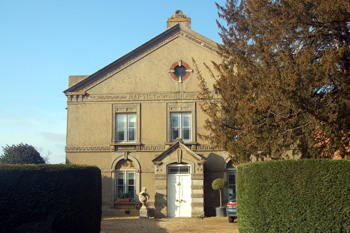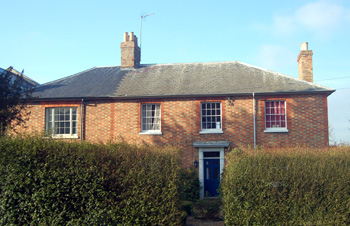
The former Baptist Chapel January 2011
Bedfordshire and Luton Archives and Records Service is lucky in having a very substantial archive deposited by the former Baptist church in Ridgmont [X347] from which a very detailed history of many pages could be written. In the eighteenth and early nineteenth centuries nonconformists were obliged to register their meeting houses, either with the Quarter Sessions or with the archdeaconry in which they were situated which, for Bedfordshire, meant the Archdeaconry of Bedford. The first surviving registration of a meeting house in Ridgmont is very early, in 1672. This was a place of worship for Congregationalists and took place in the house of William Jarvis. At that date Congregationalists and Baptists often attended one another's places of worship.
In 1690 a marriage settlement between Thomas Hollingworth and Elizabeth Jarvis, daughter of William [see above] was enacted [X347/6]. Part of the settlement was Matthew Hollingworth's messuage in Ridgmont. Thomas, in his will of 1721, left to his wife the rent "of the Meeting Place that joyneth to my house" [X347/6]. Thomas' son, also Thomas, conveyed the meeting house to trustees Joseph Bevan and Thomas Roberts in 1768 [X347/6].
Visitations by the Bishop of Lincoln to Bedfordshire in the early 18th century give some idea as to the number Baptists in Ridgmont from returns made by the vicar. Former County Archivist Patricia Bell has compiled returns from 1706 to 1720 for the Bedfordshire Historical Records Society (Volume 81, published 2002); information for Ridgmont includes the following:
- 1706: "…[it] has 82 families in it. Of these more than halfe [sic] are Anabaptists [Baptists], who have a Meeting house in this parish".
- 1709: "Families 73; Souls about 375. About halfe of them Anabaptists. They have a public Meeting. William Butler their Teacher. They meet every Sunday about 100 in number".
- 1712: "Families 65, of which 37 come all to church. The rest are mostly Anabaptists".
- 1717: "Families Sixty one Familys [sic], and Twenty four of them Dissenters, and all or most of them Anabaptists. Meeting houses We have a Licensed Meeting. I suppose they are Anabaptists. They assemble every Lord's Day by Fifty or Sixty at a time, some of them from Adjacent Parishes, and Samuel Butler leads them".
- 1720: "Families In the Parish of Ridgmont I've seventy three Families. Of these twelve are Dissenters And they go under the denomination of Anabaptists. Meeting houses I've one Licensd [sic] Meeting-House, in my said Parish, an Anabaptist. They assemble upon every Sunday. About Eighty in Number. And Samuell Butler of the said Parish is their Teacher".
These numbers vary quite considerably. It may be that the dissenters were still secretive, fearing some sort of reprisal, or it may be that the Church of England parson did not enquire too closely. Alternatively, people may have been quite volatile in their allegiance.
The first entry in the Church Book for 22nd September 1701 [X347/1] reads: "We whose names are here recorded did unanimously agree and consent and gave up ourselves together as a Church to walk together in the Fellowship of the Gospel of our Lord Jesus Christ And we Judge Union with Christ, soundness in Judgement in the Fundamentalls of the Gospel, and a Holy Conversation to be the only and sufficient grounds of the Communion of Saints…" William Jarvis was the pastor. A somewhat cryptic note in 1774 stated that the tradition was that "Mr. Bunyan" was instrumental in the founding of the church. It is possible that this did, indeed mean John Bunyan and that the church held itself to the direct descendent of the Congregationalist church registered in 1672, the year in which Bunyan was released from his imprisonment in Bedford.
It was noted in the church book in 1801 that they met in Brogborough on a Wednesday in November to "administer the Ordinance of Baptism". In 1811 the new meeting house was built, the old one being taken down. This is the building that survives today. The foundation stone was laid on 1st May. Around the same time the Duke of Bedford gave land to enlarge the burial ground.
About the time of the building of the new chapel the members of the church were in crisis; the first fifteen pages of the second Church Book [X347/2] were cut out and three pages inserted in their place which began in 1816 with: "Whereas this is the third time within a few years that this Religious Society has been threatened with total ruin by the occurrence of internal disorders…" The causes are not stated but may well have been connected with the national split which saw the division of the church into two wings, the Strict or Particular Baptists and the newer General Baptists who formed the Baptist Union in 1813. At any rate the church dissolved itself in Oct 1816 and reformed itself without deacons. Ridgmont became a Baptist Union church. In 1820 it was noted that "Mr. Foord wished to join the Methodists" and in 1822: "Brother Foord's house being used by Methodists".
Despite these problems the church was flourishing by the 1830s as in 1832 a library was started and it was recorded that 250 children attended the Sunday School. There were also "stations" in Husborne Crawley, Eversholt and Steppingley.
On Sunday 30th March 1851 a census of all churches, chapels and preaching-houses of every denomination was undertaken in England and Wales. The local results were published by Bedfordshire Historical Records Society in 1975 as Volume 54, edited by D. W. Bushby. The return for Ridgmont was made by the minister Joseph Brooks, who noted that there were 110 free seats and 215 other seats in the chapel. In the morning 150 people attended, with 300 coming in the evening. There were also 112 Sunday scholars in the morning.
In 1865 the meeting passed a resolution against frequenting drinking houses; at this time there were 97 members of whom 24 were non-resident (presumably including those in Husborne Crawley, Eversholt and Steppingley). Alterations were carried out on the chapel in 1869 and evidently Mr. Foord's defection to the Methodists had not caused too lasting a grievance as the Wesleyans "kindly offered their chapel for Sunday mornings". Indeed relations between the three churches in the village seem to have been quite cordial and some at least of the nonconformist members of the village seem to have contributed towards the building of the new Anglican church in 1854 and 1855. The chapel and its Sunday schools (one for infants the other for older children) were altered and repaired between 1881 and 1883 [X347/28-34].
![Baptist Sunday School Treat about 1910 by Jack Sharp [Z49/984]](/CommunityHistories/Ridgmont/RidgmontImages/Z49-984 Sunday School treat - photograph by Jack S_350x243.jpg)
Baptist Sunday School Treat about 1910 by Jack Sharp [Z49/984]
When Miss Janet Bolton, born in the village about 1901, recalled her childhood she remembered: "The Baptist chapel was the seat of our pleasure. A lot of children went there, and although the Chapel held about 500 people, a great many came there. One of the chief attractions was the Sunday School treat, which was held in the summer time, and we had a tea in the Schoolroom, and then went out into the meadow at the back of the Chapel, called Hollybush. There was a section of the iron fence that could be taken out, and we were able to run down into the field. We played all kinds of games, and my father and another man used to put up swings in the trees there. We thought that great fun".
The chapel was closed in 1993 and is now a private house. It was listed by the former Department of Environment in December 1991 as Grade II, of special interest. It is built in Flemish bond red brick and the rear, front and sides are all rendered. It has a slate roof with coped gable ends. It had an approximately square auditorium with gallery on three sides with the rostrum on the fourth (north-west) side and the entrance under the gallery on the opposite south-east front. A painted text was over the rostrum on the north-west wall.

17 High Street January 2011
At the same time the former manse, also now simply a private house, 17 High Street was listed as Grade II. The house had an integral school house. It was built around 1835. It is also built in red brick though the headers are biscuit coloured, giving a chequered appearance. The half hipped roof is slated. The manse was on the right hand side of the building and the school on the left. This was clearly built on the site of Thomas Hollingworth's cottage of the late 17th century.
The Rating and Valuation Act 1925 specified that every building and piece of land in the country was to be assessed to determine its rateable value. The valuer visiting the manse [DV1/C54/8] found it occupied by the minister, James Stewart. His accommodation comprised two reception rooms, a kitchen, scullery and larder and four bedrooms and a bathroom ("water has to be carried") above. A brick and slate earth closet lay outside.